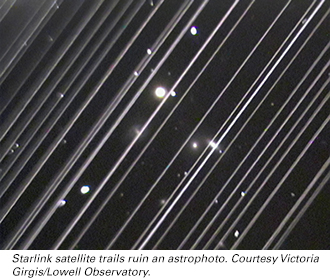AAS Works to Mitigate Impact of Satellite Constellations on Ground-Based Observing

Kelsie Krafton Space Studies Board of the NAS
 The first launch of SpaceX's Starlink satellite constellation was on 23 May 2019. The response from our community was loud enough that SpaceX reached out to the AAS looking to establish a line of communication. Since optical/infrared interference doesn’t have a statutory or regulatory framework like radio interference, they hadn’t had any interactions with that part of our community.
The first launch of SpaceX's Starlink satellite constellation was on 23 May 2019. The response from our community was loud enough that SpaceX reached out to the AAS looking to establish a line of communication. Since optical/infrared interference doesn’t have a statutory or regulatory framework like radio interference, they hadn’t had any interactions with that part of our community.
The AAS Public Policy staff worked with the AAS Committee on Light Pollution, Radio Interference, and Space Debris to assemble a working group that would be the main channel of communication between the astronomical scientific community and SpaceX.
These are the working group members:
- Jeff Hall, Lowell Observatory, Chair of the AAS Committee on Light Pollution, Space Debris, and Radio Interference, active in dark-sky preservation efforts around Arizona
- James Lowenthal, Smith College, active in dark-sky preservation efforts around Massachusetts
- Joel Parriott, AAS, Deputy Executive Officer & Director of Public Policy
- Pat Seitzer, University of Michigan, member of the AAS Committee on Light Pollution, Space Debris, and Radio Interference, conducts research in space situational awareness (SSA) and optical studies of orbital debris
- Connie Walker, Scientist at NSF’s OIR Lab, member of the AAS Committee on Light Pollution, Space Debris, and Radio Interference, president of the International Astronomical Union’s (IAU) commission on observatory site protection, past president of the Board of Directors for the Astronomical Society of the Pacific (ASP) and past BOD member and present Education Committee chair of the International Dark-Sky Association (IDA), and director of Globe at Night, the international light-pollution monitoring campaign.
And I was added when I joined the AAS Public Policy team in July. The first telecon between SpaceX and our working group was on 6 June. There have been eight telecons so far, with the last one having been on 25 November, two weeks after the second Starlink launch. The members of our working group have been making other efforts to get on top of this issue. We have met with other satellite industry players, House Science Committee staff, NSF’s Spectrum Management staff, Space Commerce, and the space law community. We also held an initial status update telecon for major US observatories and the European Southern Observatory (ESO) back in October.
Things are moving in a hopeful direction after our last two telecons. SpaceX is willing to test coatings to see if that helps bring down the brightness. Despite all the complexities of how our community makes O/IR observations, we are working to see if we can develop a brightness level for them to aim at, and we are conducting a survey of research observatories to gather this information. We also need simulations, as so far only a few people are modeling the impacts to observatories. SpaceX is also working on their own simulations to help observatories avoid Starlink. We have discussed with SpaceX the best way to disseminate their launch schedules to observatories for avoidance purposes.
SpaceX plans to have 1,584 Starlink satellites in orbit by the end of 2020. All of our options for impact mitigation will require iterative processes. Until we have collected the survey data, we and SpaceX will proceed as if satisfying the Large Synoptic Survey Telescope's needs is the high bar to aim for.
The goal of Starlink is to provide worldwide internet service, an aspiration we do not want to impede, but this requires one to two orders of magnitude more low Earth orbiting satellites (LEOs) than currently exist. We do not want to give up access to optical observations from the ground. Our group’s task is to find a path forward that accommodates both uses of the sky. If you’d like to hear more about our efforts, we have a Special Session planned for AAS 235 in Honolulu, Hawai‛i:
Challenges to Astronomy from Satellites
Wednesday, 8 January
10:00 am – 11:30 am
Ballroom AB, Hawaii Convention Center

